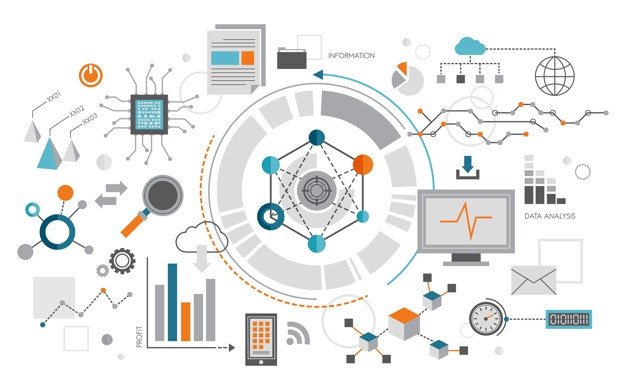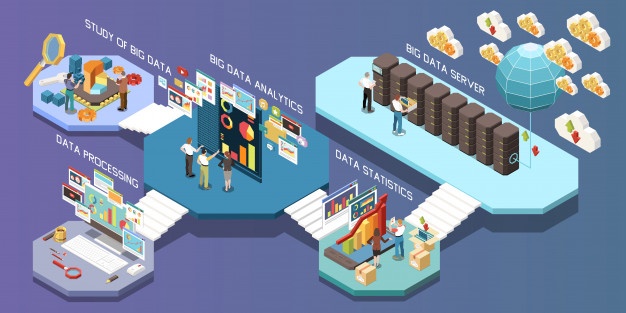Technology continues to evolve and data usage continues to increase. So, big data is an unavoidable phenomenon. The concept of big data may not be widely understood, but the benefits of big data have been widely felt, especially for internet users who access information online all the time.
In fact, there are many examples of big data that have been proven to be able to better support business processes. What is the explanation? Well, in this article, we will discuss big data in full. Starting from the understanding of big data, the characteristics of big data, and the benefits of big data and examples.
What is Big Data?

Big data is a collection of data that is very large, complex and growing all the time. This data is generated from internet activities that are increasingly routinely carried out, both for personal and business purposes.
For example, initially important information from you may be in the form of name, address and telephone number. But now, the data you have is increasingly diverse, including posts on social media, shopping history in the marketplace, to searches on search engines that show your interest in a topic.
All of this data is continuously generated along with data from other users around the world. In fact, internet users generate about 2.5 quintillion bytes of data every day!
Therefore, it is important to be able to manage big data well. So, it can be used to support your activities as a person, especially for business. In fact, the role of big data for business is quite large. For example, for website users, big data can help collect website traffic or purchase rate data easily.
Big Data Characteristics

When is the resulting data called big data? Of course, if it meets the characteristics of big data as follows:
1. Volume
The name is big data , of course the main characteristic is a very large amount of data, it can be as a whole or based on the platform that manages it.
For example, Instagram has stored 69.23% of the personal data of more than one billion users worldwide.
2. Velocity
The speed of data production is also a characteristic of big data, including data input to data usage. With the internet, this process is instantaneous and changes occur in real-time.
For example, Instagram users always add more than 100 million accounts every year. And even then with the condition that each account has different activities and continues to generate data simultaneously.
3. Variety
Big data from just one platform, namely Instagram, can take many forms. For example, there is data in the form of personal data, photos, videos, or even Instagram story filter data.
You can imagine if the data comes from various platforms and different businesses, of course the formats are different, such as presentation documents, tables, and others.
In fact, there is data that can be directly read and used and there is also abstract data that needs to be analyzed first so that it can be grouped into:
- Structured data – Can be used right away
- Semi-structured data – Needs to be processed before use
- Unstructured – Needs to be analyzed, processed, and then can be used
Whatever it is, a large variety of data is a characteristic of big data.
4. Veracity
The industrial revolution 4.0 makes the role of data in helping make decisions quite large. So, the accuracy of the data becomes important. That’s why veracity is the next big data characteristic.
It is conceivable that the larger the data, the more difficult it is to manage it properly. If an error or process error occurs, the impact can be quite large. Big data is not just about having the data generated, but about identifying the data correctly in order to provide benefits to users.
One simple example is the existence of a user account name (ID) from platforms such as Instagram, Facebook and others.
5. Value
Big data has value to make it easier for users to access information quickly and make decisions based on various existing data. For example, the Instagram Stories feature is used by 500 million users every day. This shows that features that allow users to create instant posts are quite popular.
This means that this feature needs to be maintained on the platform and even expanded with additional features such as boomerangs, multi-capture, reels and more.
Big Data Concept

The concept of big data is to collect all the data generated and then process it appropriately in order to provide the expected value.
In short, the concept of big data consists of the following three things:
- For Data Integration
- Data Management
- For Data analysis
1. Data Integration
Data integration is a process to collect all the data that has been created to become big data. For example, online store website data from new account registrations, wishlist lists, and others.
All the data will still be recorded in the system for later use in the next process. This means that in the data integration process, the main focus is only on data collection.
2. Data Management
All data generated must be able to be managed properly, both at the time of storing or accessing it. For that, we need a large storage space and can be accessed anytime and from anywhere.
For business, the use of a website with a qualified hosting service can be an option. So, all business activities and the resulting data will be processed in one place.
Later, the data on the website can be sorted into a storage system so that it is easy to find when needed.
3. Data Analysis
The last big data concept is data analysis. This means that all data that has been stored and grouped according to its type can be analyzed for further needs.
For example, the shopping history of consumers in your online store can be information about what products are worth offering when these consumers are shopping. That way, the potential for product purchases is even greater because the offer is relevant.
Now, if this can be applied to all consumers thanks to big data, then sales of business products will be able to be increased, right?
Big Data Architecture

To support the above concept, a clear big data architecture is needed. Ideally, big data is managed by using good storage technology, server networks that can be accessed at any time, and sophisticated algorithms .
For example, if you have a website or application that manages big data to support your business, here’s an illustration of the big data architecture you need:
First, the data source is a source of data that can come from various sources, for example from potential customers of your online store who will create an account by filling in their personal data.
Second, the data aggregator as a big data processing tool will receive the data and then distribute the data. There are two ways that can be used, namely:
- Real time streaming processor – Analyze real time data.
- Hadoop – A huge data repository.
Third, if the data is light, then after the real time streaming processor stage. Data will be directly stored in the data store or data storage area has been analyzed.
However, if the quantity of data is very large, then in Hadoop tools, the data must be processed with a non-real time processor system . After that, the data can be stored in the data store.
Well, the data stored in the data store can be accessed by an application or system that is directly used by the user.
The long data journey only happened in a short time. As long as the data management runs well. Otherwise, there could be a mess of data that is less useful.
Big Data Functions
Big data has several important functions in the process of developing and perfecting an application. The following are some of the functions related to big data:
1. Can determine the cause of a problem, failure in real time
The first function of big data is to determine and analyze the cause of a problem that occurs in the system. Then, with its current use, it can also minimize the occurrence of failures in the data storage process. The results of the analysis can be displayed in real-time .
2. Making a smart and right decision
Big data can also be combined with intelligent technology systems and devices such as Internet of Things (IoT) and AI ( Artificial Intelligence ). Its job is to provide and store the data and information needed in the development of a product. For example, a smart city or a smart city that uses artificial intelligence and large-scale internet networks that are able to connect every corner of the city, buildings, and other supporting infrastructure.
3. Detect an anomaly or deviant behavior in your business structure
The third function is being able to detect quickly and precisely, the form or process of activities that deviate and stop because of technical and non-technical errors. Big data can also plan several options to reduce and resolve these anomalies more quickly to help your company or organization’s business activities.
4. Reduce cost, time and improve application product performance
Data storage using a big data system can also reduce costs that must be incurred by the company. Then, the time in managing and running an operation becomes faster with data transfer above the average of other database systems. Improved performance is also a distinct advantage to support software development.
Benefits and Examples of Big Data in Business
What are the benefits of big data, especially for the business world?
1. Product Development Made Easier
Big data can help you develop products better according to consumer needs. In the end, sales can be further increased.
For example, your products that have economical packaging are more in demand. So, you can produce more of these products.
On the other hand, if there is a product whose sales are very low, then you can analyze the cause from the existing data. Then, can decide whether to repair it or stop production.
2. More Open Business Innovation Opportunities
With big data, you can identify consumer interest trends. Can be from the type of product or based on the number of transactions of a product.
Then, you can create new product innovations according to trends that are easier to attract more consumers. It could also be in the form of implementing a new system that supports product sales.
For example, many consumers like to use transfer and credit card methods for shopping. This means that the ease of payment is highly desired by consumers when visiting an online store.
As a business owner, you can work around this by providing a cashless payment method, such as a credit card or e-wallet on your online store website.
3. Can Design a More User-Friendly UX
Consumer interaction through applications, web apps, or websites, determines the level of product sales. If the flow is confusing, the resulting conversion may be small.
Well, big data can help you by storing consumer shopping history. Then, you can analyze that data to make interactions on the website more enjoyable.
For example, many consumers leave the website on the product page. So, you can learn about the quality of the page, from its appearance, speed, to navigation.
Furthermore, you can improve the appearance and speed so that the consumer shopping process can be faster and easier.
4. The Risk of Data Manipulation Can Be Avoided
Big data also has a hand in terms of security. With the sheer amount of data at hand, you can identify unusual data patterns that could hurt your business.
A simple example, if there is an expenditure figure to buy raw materials is greater than it should be.
You can use big data to get information quickly, whether there is an increase in prices or an increase in the amount of raw materials purchased.
This is important to be able to prevent data manipulation because all data has been recorded and can be accessed easily and quickly.
Big Data Challenge
While it has many benefits, there are also big data challenges that you need to be aware of. Anything?
1. Big Data System Must Always Be Updated
The development of the resulting data makes updating big data mandatory. In particular, data that is no longer relevant will reduce the accuracy of the data.
Unfortunately, updating data regularly requires speed and space to accommodate large amounts of data.
2. Lack of Expert HR
Big data certainly can’t be processed manually because it will be less effective. However, not many human resources are able to manage big data with existing technology.
Moreover, with technology that is always evolving. The ability to manage big data must also be adjusted so that the process of using big data becomes effective and efficient.
3. Quite Complicated Management
The amount of data certainly makes its management complicated. However, the latest technology has been able to make the process easier.
However, the development of big data itself is quite fast so that inappropriate platforms and infrastructure will make its management difficult. In the end, prone to data corruption, data duplication, and others.
4. Vulnerable Data Security and Privacy
The amount of data that can be accessed online by anyone and from anywhere makes it easy. However, there is a security potential that is generated such as cyber crime.
Therefore, it is important to use a platform that has good security protection. When building a business website, it is important to use a hosting service that offers reliable security features.
Ready to Manage Big Data for Your Business Progress?
Big data arises because technology is advancing and many activities are carried out online. Starting from personal activities using social media, to business activities such as product sales.
The characteristics of big data that continue to get bigger require proper management. What is the best thing to do for a business?
If you run an online business using a website, choosing hosting that suits your data needs is very important. Good to support large storage needs or access speed.



